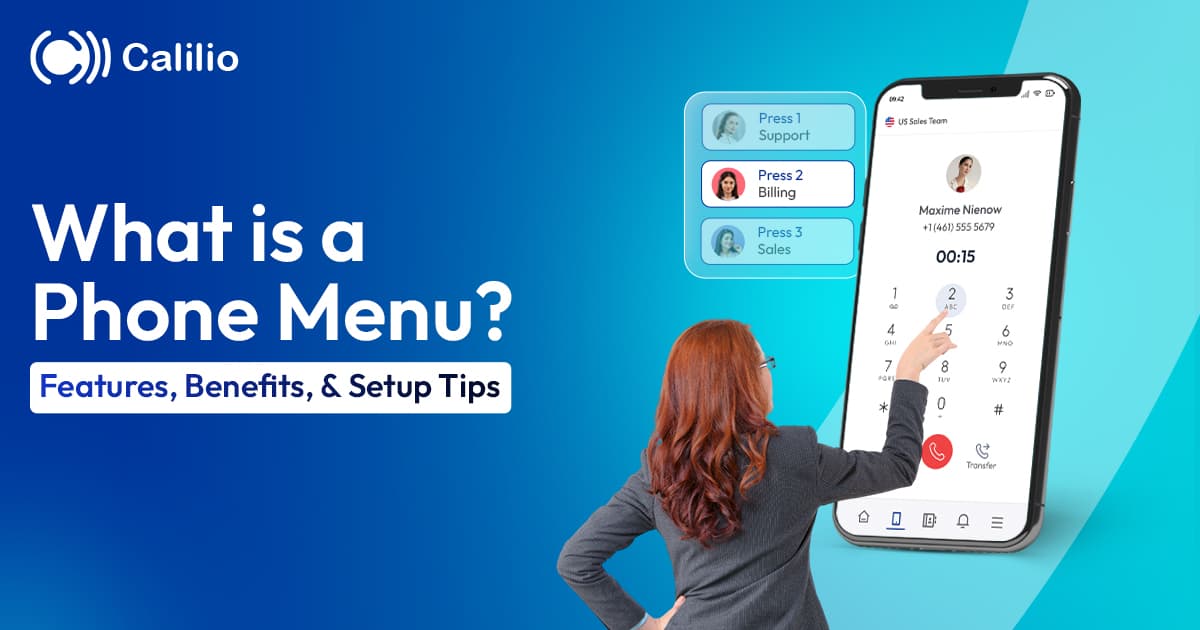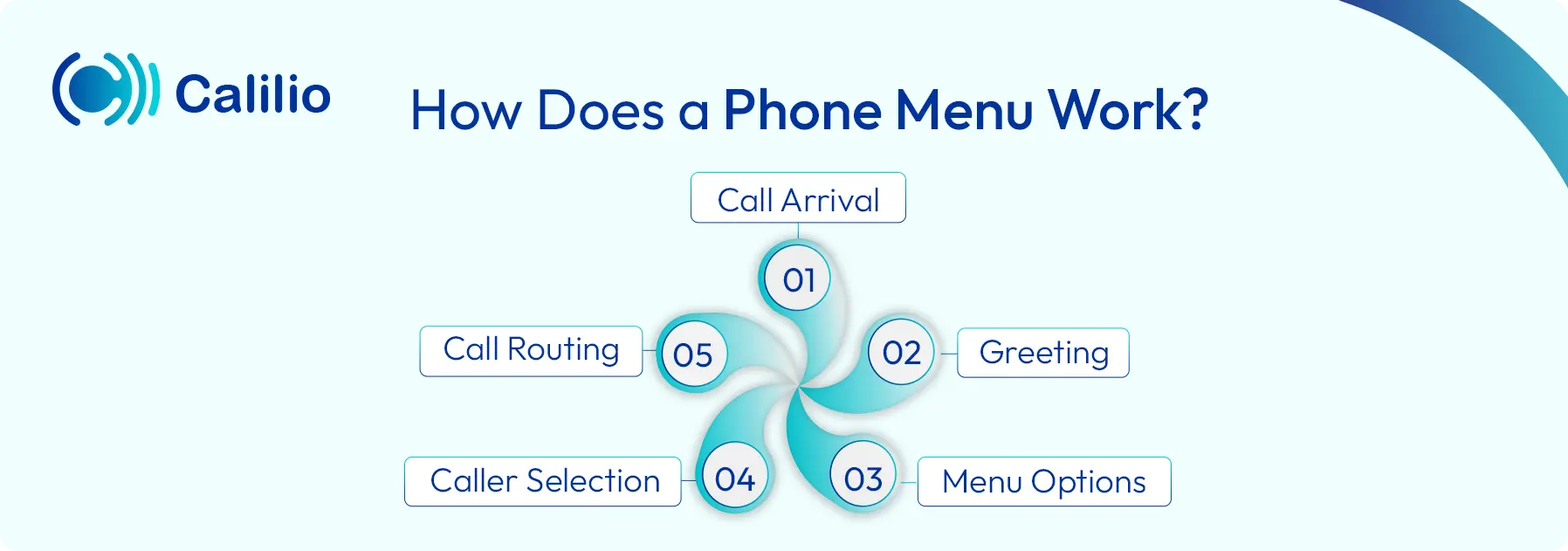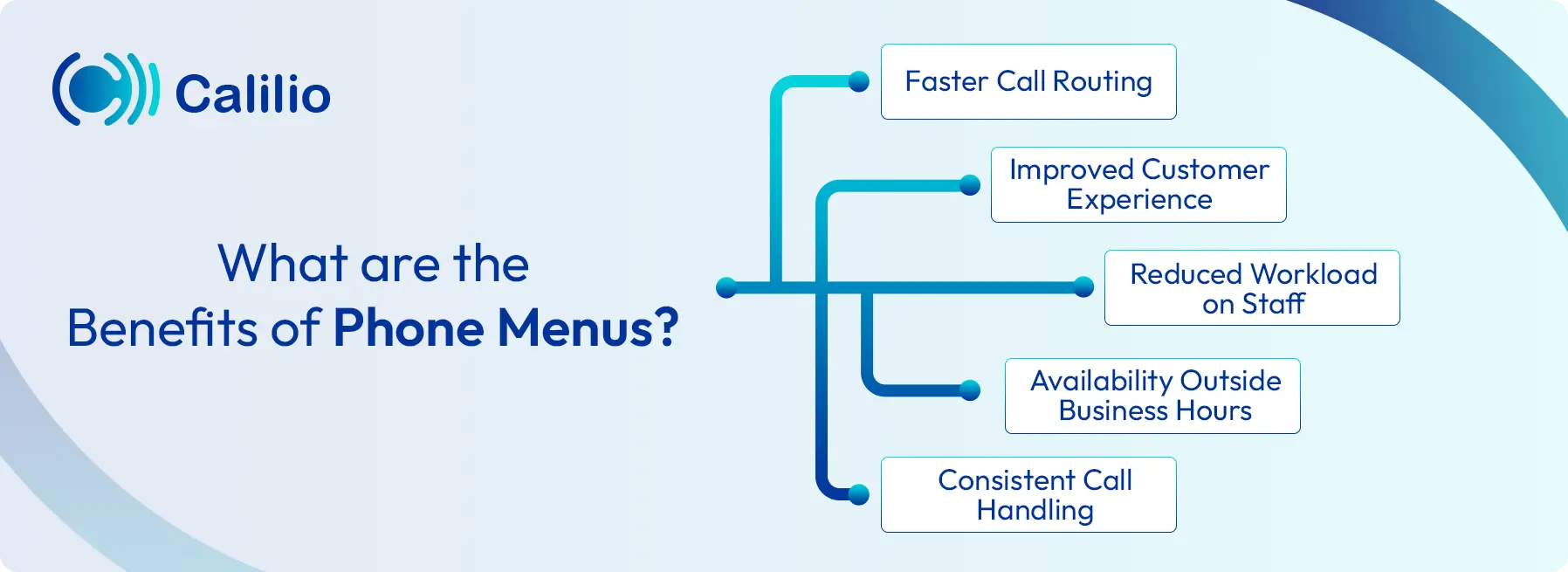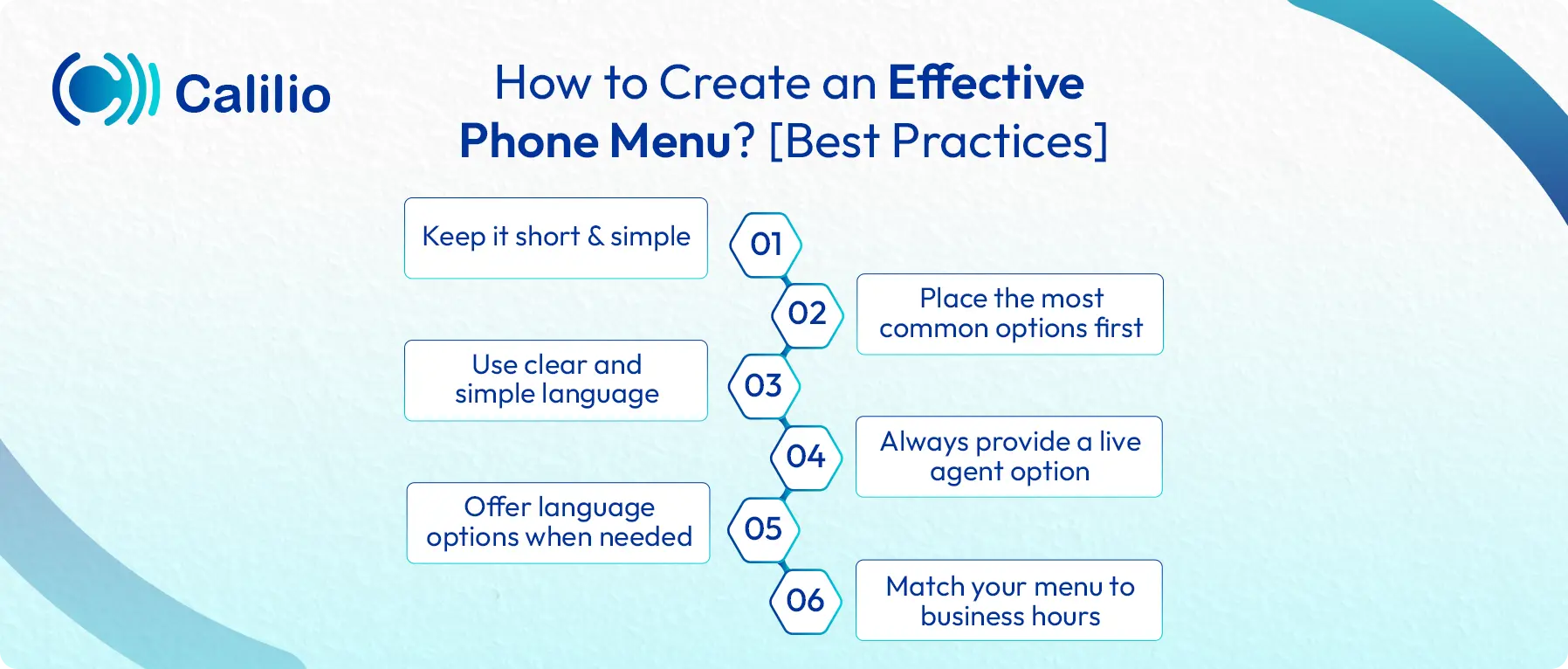What is a Phone Menu? Features, Benefits, Setup Tips & More

Businesses receive a large number of calls every day. Answering each call manually and transferring it to the right person takes time, creates confusion, and often leads to delays. That’s why many businesses use a phone menu, an automated system that helps guide callers to the right department or person without needing human assistance.
However, just having a phone menu is not enough. It also needs to be well-designed—simple, clear, and easy to use. A confusing or poorly structured menu can do more harm than good, as it may frustrate callers, lead to misrouted calls, or even cause customers to hang up.
To make things simple, let’s explore what a phone menu is in detail and how to set it up effectively.
Key Highlights:
A phone menu lets callers navigate a phone system to reach a specific department or person by pressing a key or speaking a command.
A well-structured automated call menu improves both business efficiency and customer satisfaction.
There are three types of automated phone menus: single-level, multi-level (nested), and dynamic menus for personalized caller experiences.
Some of the must-have features in a phone call menu include clear and simple menu options, multilingual support, flexible call routing, and self-service functionalities.
For effective call menus, keep your menus short, use clear language, offer multi-language support, and always provide an option to talk to live agents.
What is a Phone Menu?
A phone menu is an automated phone system that presents a set of options to callers when they contact a business. It is an essential part of an IVR (Interactive Voice Response) system that helps to guide callers to the appropriate department or provide answers without needing a live representative. Since it is a core component of the IVR, it is also often referred to as an IVR menu.
How Does a Phone Menu Work?
A phone menu greets the caller with a recorded message and presents a set of options they can select using their dial pad. These options route the caller to the appropriate department, agent, or service, helping them get the information or support they need quickly and efficiently.

- Call Arrival: A customer dials your business number, and the system receives the call.
- Greeting: The caller hears a pre-recorded welcome message.
- Menu Options: The IVR system presents the automated phone menu options, for example, “Press 1 for Sales, Press 2 for Support.”
- Caller Selection: The caller selects an option from the automated menu by pressing a number or speaking a command.
- Call Routing: Finally, the system automatically directs the call to the appropriate destination, such as a specific agent, department, recorded message, or voicemail.
Types of Phone Menu Options
A phone menu is primarily classified into 3 main types: Single-level menu, Multi-level menu, and Dynamic menu.
1. Single-level Menu
A single-level phone menu is a simple, one-tier IVR menu that presents all menu options in a single list. Once the caller makes a selection, they are connected directly to the appropriate destination without having to navigate other submenus. This type of menu is often used by small businesses, as they have limited services.
For example: “Thank you for calling ABC Company. Press 1 for Sales, Press 2 for Support, or Press 3 for Business Hours.”
2. Multi-level Menu (Nested Menu)
A multi-level call menu, also called a hierarchical menu, offers multiple tiers of options, allowing callers to navigate through submenus to reach the right destination. After selecting an initial option, the caller may be presented with additional choices to narrow down their request, ensuring they are routed accurately.
For example, a caller is first presented with a menu to select a language. Then, they are provided with the options, such as Support or Sales. If they select sales, a submenu appears with further choices such as Product Information, Billing, or Shipping details. Based on their selection, the caller either receives the requested information or the system routes the call to the appropriate agent.
3. Dynamic Menu
A dynamic phone call menu changes its options in real time based on caller information or business rules. Instead of showing the same choices to every caller, it can adapt depending on factors like caller history, location, or account type, providing a more personalized experience.
For example, a returning customer who previously contacted support about a billing issue calls again. Instead of hearing the full main menu, the system recognizes their number and immediately offers options like "Press 1 to continue your billing inquiry" or "Press 2 to speak with your previous agent."
What are the Key Features to Look for in a Phone Menu?
A good phone menu should offer interactive options via keypad or voice commands. Moreover, it should also include custom greetings, multi-language support, and self-service options.
- Interactive Options: Callers should be able to select options from the call menu using either keypad input or voice commands.
- Call Routing: Once a choice is made, the system should seamlessly direct the call to the appropriate department, agent, or service according to the predetermined call flow.
- Custom Greetings: The system should be designed to greet the callers professionally with pre-recorded or text-to-speech messages. Moreover, businesses must have an option to update greetings for promotions, holidays, or urgent announcements, keeping the interaction relevant.
- Multi-Language Support: Multilingual support helps to offer instructions in multiple languages, catering to international or multilingual customers. At the start of the call, callers can select their preferred language, ensuring clarity from the beginning.
- Self-Service Options: Callers should be provided an option to perform routine tasks without human assistance, such as checking account status, tracking delivery, or leaving messages. It not only enhances customer experience but also helps to reduce and manage employees’ workload.
What are the Benefits of Phone Menus?
Automated menus help callers reach the right person or department quickly, making it easier for customers to get the support they need while reducing the workload on staff. Furthermore, they provide access to information even outside of business hours and ensure every caller receives clear, consistent, and professional service.

- Faster Call Routing: Phone call menus automatically guide callers to the right department, eliminating unnecessary transfers. It ensures that customers reach the right person instantly without going through other operators.
- Improved Customer Experience: As the caller gets the right help immediately, it reduces call waiting time, and customers feel more satisfied with the service.
- Reduced Workload on Staff: Since the calls are routed automatically, employees spend less time transferring calls and more time focusing on resolving customer issues.
- Availability Outside Business Hours: Using an IVR menu ensures that even when your team is offline, customers can reach your business. It helps handle after-hours calls and keeps your business accessible 24/7.
- Consistent Call Handling: With a pre-designed call menu, every caller hears the same instructions and follows the same process. This ensures fair and consistent service for all customers.
Upgrade to a Business Phone System with a Customizable IVR Phone Menu
How to Set Up a Phone Menu?
To set up an automated phone menu, start by selecting the right phone system and mapping out the call flow. Create a clear menu script, record professional greetings, and configure the system accordingly. Finally, test the setup thoroughly and monitor performance to ensure a positive caller experience.
- Choose the Right Phone System: Select a business phone system that supports call menus or IVR features.
- Plan the Call Flow: Decide where each menu option should lead, such as sales, support, billing, recorded information, or voicemail.
- Write a Clear Menu Script: Draft simple and concise prompts that guide callers effectively. For example: “Press 1 for Sales, Press 2 for Support, Press 3 for Billing.”
- Record Greetings and Prompts: Use a professional and friendly tone to welcome the caller and guide them through the menus.
- Set Up the Menu in Your System: Assign each menu option to its destination. This could be a team member, department, voicemail, or even a pre-recorded message.
- Test the Menu: Test the menu to make sure all options work correctly and navigation is smooth. Adjust any confusing prompts or routing issues.
- Launch and Monitor: Once the menu works as intended, make it available to callers. Keep track of usage and feedback so you can refine the menu over time as your business or call volume changes.
How to Create an Effective Phone Menu? [Best Practices]
To create an effective phone menu, keep the menu concise, avoid long or confusing phrases, and always provide an option to talk to a live agent. Additionally, include language selections if needed and set up different menus according to your business hours.

- Keep it short and simple: You must limit your call menus to just 3-5 options. Long menus often frustrate callers and lead to hang-ups before they even reach the right agents.
- Place the most common options first: Your phone menu options should include the most frequently used departments, like Sales or Support, at the top of the menu. This helps customers reach their destination faster and prevents them from waiting through unnecessary options.
- Use clear and simple language: Try to avoid complicated terms as well as long phrases. Use language that is both clear and simple. Use straightforward words so callers immediately understand the options, such as “Billing” or “Support”.
- Always provide a live agent option: Ensure that there is a direct option to transfer the call to a live agent, bypassing the phone menus. This lets customers quickly get human assistance when needed, especially for urgent or complex issues.
- Offer language options when needed: If your business serves global customers, make sure your IVR offers phone menus in multiple languages. A multilingual IVR phone menu ensures callers can navigate easily and makes your system more inclusive and user-friendly.
- Match your menu to business hours: Businesses need to set up different menus for office hours and after-hours. During business hours, your team can handle calls, and outside those hours, the system can direct callers to voicemail or prerecorded information.
Conclusion
A phone menu is an essential part of guiding callers to the right department, agent, or service. By presenting clear options, it streamlines calls, reduces wait times, and improves overall customer experience. As a core element of the IVR system, a well-structured phone menu directly enhances the call flow efficiency and ensures professional, organized call handling for your business.
Frequently Asked Questions
What is a menu on a phone?
A menu on a phone is the list of options you hear or view when you call a business. It guides you to reach your desired department or service.
How many phone menus can I have?
What are the practical uses of a phone menu?

Still have questions?
Can’t find the answer you’re looking for? Please chat with our friendly team.
Stay in the loop
Get the latest call insights, trends, and updates delivered straight to your inbox.
By subscribing, you agree to receive updates from Calilio.
You can unsubscribe anytime.
Phone numbers
Get International Phone Numbers
Singapore
|Australia
|New Zealand

